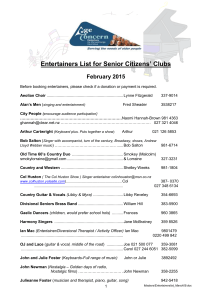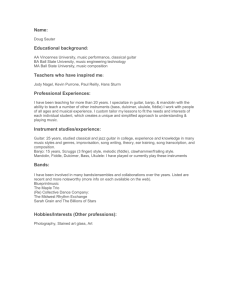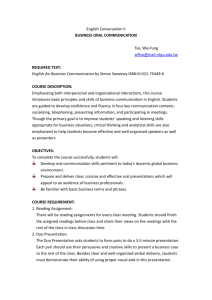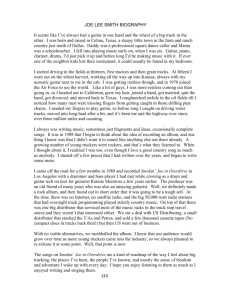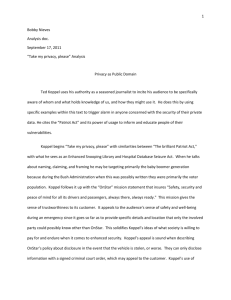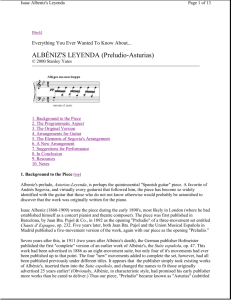Sunday April 10, 2011, 8:00 pm Fairchild Chapel Concert No. 259 G
advertisement
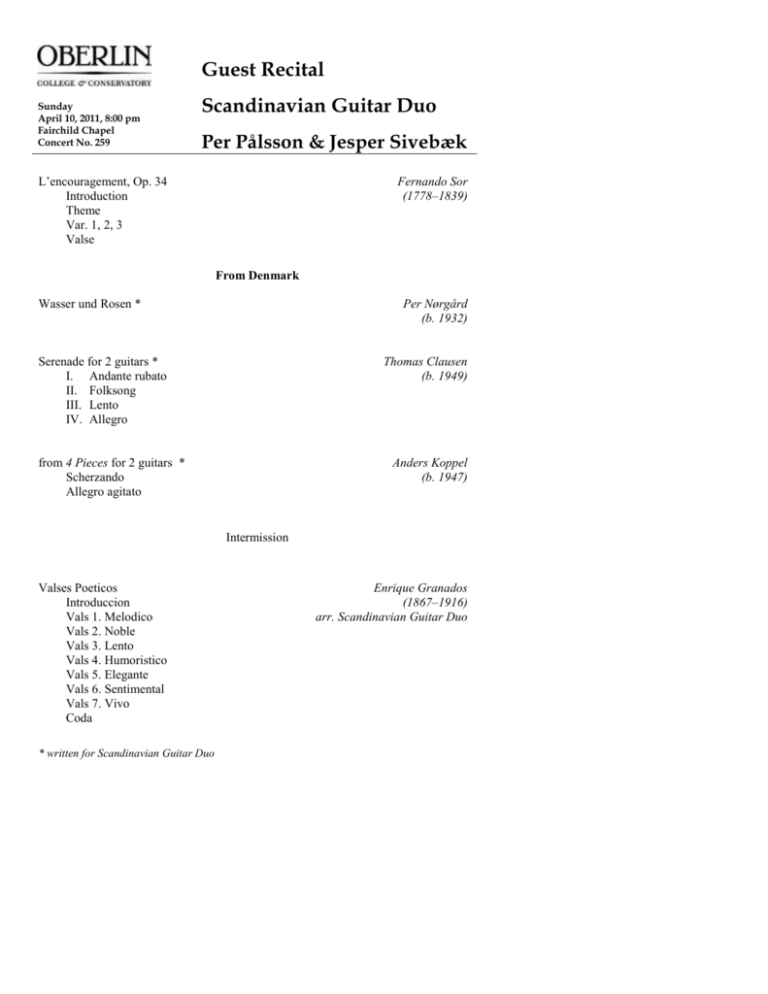
Guest Recital Sunday April 10, 2011, 8:00 pm Fairchild Chapel Concert No. 259 Scandinavian Guitar Duo Per Pålsson & Jesper Sivebæk L’encouragement, Op. 34 Introduction Theme Var. 1, 2, 3 Valse Fernando Sor (1778–1839) From Denmark Wasser und Rosen * Per Nørgård (b. 1932) Serenade for 2 guitars * I. Andante rubato II. Folksong III. Lento IV. Allegro Thomas Clausen (b. 1949) from 4 Pieces for 2 guitars * Scherzando Allegro agitato Anders Koppel (b. 1947) Intermission Valses Poeticos Introduccion Vals 1. Melodico Vals 2. Noble Vals 3. Lento Vals 4. Humoristico Vals 5. Elegante Vals 6. Sentimental Vals 7. Vivo Coda * written for Scandinavian Guitar Duo Enrique Granados (1867–1916) arr. Scandinavian Guitar Duo from Suite Española, Op. 47 Sevilla Granada Asturias Isaac Albéniz (1860–1909) arr. Scandinavian Guitar Duo Please silence all cell phones and refrain from the use of video cameras unless prior arrangements have been made with the performers. The use of flash cameras is prohibited. Thank you. Biographies The guitarists Per Pålsson and Jesper Sivebæk started their carrier as the Scandinavian Guitar Duo in 1993 when they won the first prize in Danish Radio’s prestigious Chamber Music Competition. Following this success the duo has received many awards and exclusive prizes such as the special “Segovia Award” from the Leonie Sonning Foundation. Other awards include prizes from both King Frederik and Queen Ingrid´s Foundation, and King Christian X´s Foundation. The Scandinavian Guitar Duo has played more than 500 concerts especially in the Scandinavian countries. They perform regularly at international festivals, give master classes, broadcast on radio, and television. Apart from playing concerts Per Pålsson teaches at the Academy of Music in Esbjerg, Sweden and Jesper Sivebæk teaches at the Academy of Music in Odense and Copenhagen in Denmark. Fernando Sor, one of the great figures in the history of guitar, was an all-round musician and composer. Although he was acknowledged in his lifetime as a fine performer (“Sor ... who is known to be the most perfect guitarist in the world,” wrote Ebers in London), he was not associated with that instrument as strongly as was, for example, Giuliani. He had been a chorister at the monastery of Montserrat (near Barcelona), where he received an education in church music and composition and in orchestral playing, and later in life he composed music not only for the guitar but also for voice, piano, orchestra, etc. Until 1813 (when he was 35) he lived entirely in Spain. He fought in the Spanish War of Independence when Napoleon invaded Spain in 1808. After a brief stay in Paris in 1813, Sor settled in London. A journey to Moscow followed and Sor then spent the rest of his life in Paris. He became a teacher of the guitar and it was there that he composed the many works for beginners on the guitar - Op. 31, 35, and 60 – which have been called the finest works ever written for beginners on the instrument. Per Nørgård (b. 1932) is one of the most original artists in the cultural life of Denmark. His work and efforts as composer, teacher, and theorist through almost half a century has had an enormous significance to the development of contemporary Danish art music. Nørgård has written works in all categories, for amateurs as well as for professionals, from large-scale operas to modest hymns, from simple movements to imposing edifices. As a young man, Nørgård was a student of Vagn Holmboe, and indeed his early works display that he was inspired by the Nordic character of his teacher. From this period, the 1st Symphony and Constellations for strings are key works. During the last half of the 1950s, Nørgård expanded his compositional field of vision by exploring the new possibilities in Central European modernism. His occupation with new structural approaches lead to the discovery of the so-called infinity row; a serial system or musical growth principle, which can be compared to the symmetrical formations of nature. This way of composing has been compared with fractional geometrical forms edifying structures in an indefinite, hierarchical system. Amongst the works that employ this technique, the significant 3rd Symphony assumes a prominent position. But in Per Nørgård, the artistic universe is connected from beginning to end as one big work in progress. This is a paradox, because, as mentioned, in his music through the years, the composer has been continuously breaking with his own traditions, in the name of self-transgression: Ironic pastiches, infinity rows, Golden Section proportions, beauty-seeking metaphysics in the 70s, via the wrestling of the 80s with great existential questions, centred around a large group of works strongly inspired by the schizophrenic artist Adolf Wölfli, to the experiments in the 90s with those phenomena that Nørgård himself calls ‘tone lakes’ - all these are constituent methods for generating new tone rows to support the superior will to express. A survey of Nørgård’s output creates an image of a superior project: The wish to create music that unfolds like meetings between elements of differing natures. It may be the triteness of everyday-life that gains meaning in the middle of a pompous passage in a symphony. Rationality and spontaneity, structure and freedom, yin and yang, local and global, system and chaos, art and kitsch, construction and expression in Per Nørgård’s universe, opposites are constantly taken into consideration. The tension or interference in Nørgård’s music is this dialectic between opposite tendencies in the different material layers. Per Nørgård’s art constantly creates the vision that the potential of music is far greater than we think. The conductor Sergiu Celibidache once precisely expressed the potential of Nørgård’s large-scale, faultless creation: “Only the mind of a new time in the new millennium will be able to understand the scope of Nørgård’s music.” Per Nørgård received the Wilhelm Hansen Composer Prize 2000. Anders Koppel, composer and musician, was born 1947. He played the piano as a child and later clarinet with several television and concert appearances. In 1966 he began playing the organ and was a co-founder in 1967 of the rock group Savage Rose which toured all over Europe and the USA. In 1976 he co-founded the trio Bazaar, which has released 9 albums. In the years 1974-80 he was very active as a producer and studio musician. Since then he has concentrated on his work as a composer alongside touring with ’Bazaar’. Furthermore he plays in the trio Koppel-AndersenKoppel which includes his son, the saxophone player Benjamin Koppel (CD: Kakophonia 2000). Anders Koppel has composed music for 8 ballets for the New Danish Dance Theatre and music for more than 150 movies, 50 theatrical plays, and 3 musicals. Anders Koppel has also composed works for different classical ensembles: Toccata for vibraphone and marimba (1990), performed all over the world and recorded by Safri Duo, Concerto for saxophone and orchestra (1992), which had its concert premiere at the Numus Festival in Aarhus in April 1997, and Concerto for marimba and orchestra (1995), which has been performed all over Europe. Anders Koppel has received several prizes and rewards, and the composer has twice been awarded a ‘Robert’ for best film score (1994 and 1996). Koppel wrote 4 Pieces for the Scandinavian Guitar Duo. Isaac Albéniz is one of the most colourful personalities in music history. He was born in 1860 in Catalonia and, as a pianistic child prodigy, had a turbulent and adventurous childhood. As early as the age of four, he made his debut with his sister and entered the academy of music in Madrid at the age of eight – he had previously ruined his chances of being accepted by the academy of music in Paris when he broke a large mirror with a ball in this distinguished institution. During his time in Madrid, he went on small tours where he made ends meet by selling improvisations, written down on the spot, over themes provided by the audience. Threatened with imprisonment in Cadiz if he did not return home from one of these self-arranged tours, he stowed away on board the steamer “España” to South America. He played his way through Argentina, Uruguay, and Brazil, then on to Cuba and the USA. Later he returned to Europe, further developed his piano technique with the help of Franz Liszt and began to compose seriously under the inspiration of, among others, Paul Dukas and Claude Debussy. Debussy characterised Albéniz’s compositions saying, “Never before has music been so full of impressions or so many colours.” Ideas surrounding musical nationalism are crystallized to appear as an apotheosis of Spanish musical expression, permeated with the mood and atmosphere of life in Spain in the works Suite Española and Iberia. As Albéniz himself expressed it, “ What interests me is the blazing sun that lifts up the narrow streets...if only I could put it into music.”
